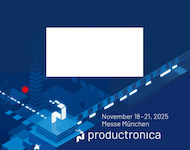SMT & Inspection |
The Next Generation in Handling Moisture Sensitive Devices
The influence of humidity on the reliability of electronic components is generally underestimated and often simply unknown. Moisture sensitive devices (MSDs) are electronic components encapsulated with plastic compounds and other organic materials. Moisture from atmospheric humidity enters these permeable packaging materials by diffusion and collects at the interfaces of dissimilar material.
The moisture sensitivity of a particular package is influenced by different factors, including the internal dimensions and design of the lead frame, the external dimension of the package, and the physical properties of the die attach material and molding compound.
How much moisture a particular package actually absorbs depends on factors such as temperature, the physical properties of the mold compound, the relative humidity of the ambient atmosphere, and how much time the component is exposed to those conditions.
The diffusion rate of moisture into the mold compound is temperature‐dependent. The higher the temperature, the faster the surrounding moisture will penetrate the mold compound. The absorption process will continue until the internal moisture concentration reaches equilibrium with the ambient relative humidity. The higher the relative humidity, the greater the amount of absorbed moisture within the plastic package.
 Lower volume, higher mix production environments find themselves more at risk without proper handling procedures in place as well, as individual trays or reels of components take longer to empty and parts have more time to absorb moisture.
The original IPC/JEDEC J‐STD‐033 was designed to address the problems associated with Moisture Sensitive Devices (MSD). The standard contains handling, packing, shipping and implementation recommendations and guidelines. In summation, the manufacturer of a moisture sensitive component must test and classify the device based upon a maximum floor life at 30 deg. C at 60% Relative Humidity (prior to reflow). The component is dry‐packed with proper identification prior to shipment to the assembler. Theoretically, once the dry bags are opened, the components must be assembled and reflowed within the specified time limits.
Lead Free processing increases MSD problems dramatically
With the introduction of lead free, the risks associated with marginal or improper handling of MSDs has increased dramatically. Higher reflow temperatures drive up the saturated vapor pressure to double or even triple that present in tin lead reflow processes. The higher temperature increases the water pressure inside the components, and as a result, the allowable moisture content and associated floor life have to be reduced. All moisture‐sensitive components have to be requalified by their manufacturers for lead‐free and they are typically downgraded by at least one and generally two levels of sensitivity. This significantly affects how components must be are handled, processed and stored.
Suddenly, manufacturers that are currently handling MSL 2 or MSL 3 components are now looking at processing MSL 5 or MSL 6. The SMTA’s MSD Council is among the those who have reported that even passive components (ceramic chip resistors and capacitors), normally classified as MSL 1 ( unlimited floor life) have shown field failures after lead free reflow due to presence of moisture in the component. Another major impact of lead free reflow for assemblers is the handling and storage of PWBs, as the incidence of delamination has increased with the change in thermal processing. PWBs need to be treated as MSL classification 4, in other words processed within 72 hours of open shop floor time.
Dry Solutions
In the same way that electrostatic discharge (ESD) became an important focus of attention 10 years ago, the increasing rate of failures associated with moisture sensitivity today is requiring that manufacturers invest more time and energy in finding useful and cost effective solutions.
Engineers have a variety of ways in which to combat moisture. Some methods address storage, in an attempt to “stop the clock” dictated by the respective MSL of the device. Beyond that are methods of drying, removing moisture that has been absorbed by the devices and in effect “turning back the clock.” “Baking” components is a standard method that has been employed for years and is in fact cited within IPC/JEDEC J‐STD‐033. This method is not without its drawbacks, however, particularly that of oxidation.
Lower volume, higher mix production environments find themselves more at risk without proper handling procedures in place as well, as individual trays or reels of components take longer to empty and parts have more time to absorb moisture.
The original IPC/JEDEC J‐STD‐033 was designed to address the problems associated with Moisture Sensitive Devices (MSD). The standard contains handling, packing, shipping and implementation recommendations and guidelines. In summation, the manufacturer of a moisture sensitive component must test and classify the device based upon a maximum floor life at 30 deg. C at 60% Relative Humidity (prior to reflow). The component is dry‐packed with proper identification prior to shipment to the assembler. Theoretically, once the dry bags are opened, the components must be assembled and reflowed within the specified time limits.
Lead Free processing increases MSD problems dramatically
With the introduction of lead free, the risks associated with marginal or improper handling of MSDs has increased dramatically. Higher reflow temperatures drive up the saturated vapor pressure to double or even triple that present in tin lead reflow processes. The higher temperature increases the water pressure inside the components, and as a result, the allowable moisture content and associated floor life have to be reduced. All moisture‐sensitive components have to be requalified by their manufacturers for lead‐free and they are typically downgraded by at least one and generally two levels of sensitivity. This significantly affects how components must be are handled, processed and stored.
Suddenly, manufacturers that are currently handling MSL 2 or MSL 3 components are now looking at processing MSL 5 or MSL 6. The SMTA’s MSD Council is among the those who have reported that even passive components (ceramic chip resistors and capacitors), normally classified as MSL 1 ( unlimited floor life) have shown field failures after lead free reflow due to presence of moisture in the component. Another major impact of lead free reflow for assemblers is the handling and storage of PWBs, as the incidence of delamination has increased with the change in thermal processing. PWBs need to be treated as MSL classification 4, in other words processed within 72 hours of open shop floor time.
Dry Solutions
In the same way that electrostatic discharge (ESD) became an important focus of attention 10 years ago, the increasing rate of failures associated with moisture sensitivity today is requiring that manufacturers invest more time and energy in finding useful and cost effective solutions.
Engineers have a variety of ways in which to combat moisture. Some methods address storage, in an attempt to “stop the clock” dictated by the respective MSL of the device. Beyond that are methods of drying, removing moisture that has been absorbed by the devices and in effect “turning back the clock.” “Baking” components is a standard method that has been employed for years and is in fact cited within IPC/JEDEC J‐STD‐033. This method is not without its drawbacks, however, particularly that of oxidation.
 Additionally taped components cannot be exposed to 125o C temperatures commonly used without destroying the tapes. And with more and more components and PWBs requiring special handing attention, a new shop floor materials logistics problem arises, with different baking times and temperatures. The results are often that components can be left in the ovens for hours at a time after baking. The result? In this ambient atmosphere moisture is once again being absorbed back into the components.
Source: Whitepaper: The Next Generation in Handling Moisture Sensitive Devices from Totech.
Additionally taped components cannot be exposed to 125o C temperatures commonly used without destroying the tapes. And with more and more components and PWBs requiring special handing attention, a new shop floor materials logistics problem arises, with different baking times and temperatures. The results are often that components can be left in the ovens for hours at a time after baking. The result? In this ambient atmosphere moisture is once again being absorbed back into the components.
Source: Whitepaper: The Next Generation in Handling Moisture Sensitive Devices from Totech.
 Lower volume, higher mix production environments find themselves more at risk without proper handling procedures in place as well, as individual trays or reels of components take longer to empty and parts have more time to absorb moisture.
The original IPC/JEDEC J‐STD‐033 was designed to address the problems associated with Moisture Sensitive Devices (MSD). The standard contains handling, packing, shipping and implementation recommendations and guidelines. In summation, the manufacturer of a moisture sensitive component must test and classify the device based upon a maximum floor life at 30 deg. C at 60% Relative Humidity (prior to reflow). The component is dry‐packed with proper identification prior to shipment to the assembler. Theoretically, once the dry bags are opened, the components must be assembled and reflowed within the specified time limits.
Lead Free processing increases MSD problems dramatically
With the introduction of lead free, the risks associated with marginal or improper handling of MSDs has increased dramatically. Higher reflow temperatures drive up the saturated vapor pressure to double or even triple that present in tin lead reflow processes. The higher temperature increases the water pressure inside the components, and as a result, the allowable moisture content and associated floor life have to be reduced. All moisture‐sensitive components have to be requalified by their manufacturers for lead‐free and they are typically downgraded by at least one and generally two levels of sensitivity. This significantly affects how components must be are handled, processed and stored.
Suddenly, manufacturers that are currently handling MSL 2 or MSL 3 components are now looking at processing MSL 5 or MSL 6. The SMTA’s MSD Council is among the those who have reported that even passive components (ceramic chip resistors and capacitors), normally classified as MSL 1 ( unlimited floor life) have shown field failures after lead free reflow due to presence of moisture in the component. Another major impact of lead free reflow for assemblers is the handling and storage of PWBs, as the incidence of delamination has increased with the change in thermal processing. PWBs need to be treated as MSL classification 4, in other words processed within 72 hours of open shop floor time.
Dry Solutions
In the same way that electrostatic discharge (ESD) became an important focus of attention 10 years ago, the increasing rate of failures associated with moisture sensitivity today is requiring that manufacturers invest more time and energy in finding useful and cost effective solutions.
Engineers have a variety of ways in which to combat moisture. Some methods address storage, in an attempt to “stop the clock” dictated by the respective MSL of the device. Beyond that are methods of drying, removing moisture that has been absorbed by the devices and in effect “turning back the clock.” “Baking” components is a standard method that has been employed for years and is in fact cited within IPC/JEDEC J‐STD‐033. This method is not without its drawbacks, however, particularly that of oxidation.
Lower volume, higher mix production environments find themselves more at risk without proper handling procedures in place as well, as individual trays or reels of components take longer to empty and parts have more time to absorb moisture.
The original IPC/JEDEC J‐STD‐033 was designed to address the problems associated with Moisture Sensitive Devices (MSD). The standard contains handling, packing, shipping and implementation recommendations and guidelines. In summation, the manufacturer of a moisture sensitive component must test and classify the device based upon a maximum floor life at 30 deg. C at 60% Relative Humidity (prior to reflow). The component is dry‐packed with proper identification prior to shipment to the assembler. Theoretically, once the dry bags are opened, the components must be assembled and reflowed within the specified time limits.
Lead Free processing increases MSD problems dramatically
With the introduction of lead free, the risks associated with marginal or improper handling of MSDs has increased dramatically. Higher reflow temperatures drive up the saturated vapor pressure to double or even triple that present in tin lead reflow processes. The higher temperature increases the water pressure inside the components, and as a result, the allowable moisture content and associated floor life have to be reduced. All moisture‐sensitive components have to be requalified by their manufacturers for lead‐free and they are typically downgraded by at least one and generally two levels of sensitivity. This significantly affects how components must be are handled, processed and stored.
Suddenly, manufacturers that are currently handling MSL 2 or MSL 3 components are now looking at processing MSL 5 or MSL 6. The SMTA’s MSD Council is among the those who have reported that even passive components (ceramic chip resistors and capacitors), normally classified as MSL 1 ( unlimited floor life) have shown field failures after lead free reflow due to presence of moisture in the component. Another major impact of lead free reflow for assemblers is the handling and storage of PWBs, as the incidence of delamination has increased with the change in thermal processing. PWBs need to be treated as MSL classification 4, in other words processed within 72 hours of open shop floor time.
Dry Solutions
In the same way that electrostatic discharge (ESD) became an important focus of attention 10 years ago, the increasing rate of failures associated with moisture sensitivity today is requiring that manufacturers invest more time and energy in finding useful and cost effective solutions.
Engineers have a variety of ways in which to combat moisture. Some methods address storage, in an attempt to “stop the clock” dictated by the respective MSL of the device. Beyond that are methods of drying, removing moisture that has been absorbed by the devices and in effect “turning back the clock.” “Baking” components is a standard method that has been employed for years and is in fact cited within IPC/JEDEC J‐STD‐033. This method is not without its drawbacks, however, particularly that of oxidation.
 Additionally taped components cannot be exposed to 125o C temperatures commonly used without destroying the tapes. And with more and more components and PWBs requiring special handing attention, a new shop floor materials logistics problem arises, with different baking times and temperatures. The results are often that components can be left in the ovens for hours at a time after baking. The result? In this ambient atmosphere moisture is once again being absorbed back into the components.
Source: Whitepaper: The Next Generation in Handling Moisture Sensitive Devices from Totech.
Additionally taped components cannot be exposed to 125o C temperatures commonly used without destroying the tapes. And with more and more components and PWBs requiring special handing attention, a new shop floor materials logistics problem arises, with different baking times and temperatures. The results are often that components can be left in the ovens for hours at a time after baking. The result? In this ambient atmosphere moisture is once again being absorbed back into the components.
Source: Whitepaper: The Next Generation in Handling Moisture Sensitive Devices from Totech.


